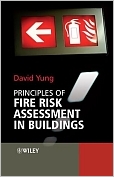| |||||
• polskie
• Zamów informacje o nowościach z wybranego tematu • kontakt |
PRINCIPLES OF FIRE RISK ASSESSMENT IN BUILDIGSYUNG D.wydawnictwo: WILEY, 2008, wydanie Icena netto: This book arrives at just the right time to facilitate understanding of performance-based fire risk assessment in buildings – an integral part of the global shift in policy away from traditional prescriptive codes. Yung, an internationally recognised expert on the subject of fire risk assessment, introduces the basic principles and techniques that help the reader to understand the various methodologies that are currently in place or being proposed by different organisations. Through his illustration of basic principles and techniques he enables the reader to conduct their own fire risk assessments. He demonstrates how the probabilities of fire scenarios are assessed based on the probabilities of success and failure of fire protection measures that are in place. He also shows how the consequences of fire scenarios are assessed based on the intensity and speed of fire and smoke spread, the probability and speed of occupant response and evacuation, and the effectiveness and speed of fire department response and rescue efforts. Yung’s clear and practical approach to this highly topical subject enables the reader to integrate the various tools available into a quantitative framework that can be used for decision making. He brings an invaluable resource to all those involved in fire engineering and risk assessment, including students, academics, building designers, fire protection engineers, structural engineers, regulators and risk analysts. Table of Contents
About the Author. Preface. Acknowledgements. List of Symbols. 1. Introduction. PART I: SIMPLE APPROACH TO FIRE RISK ASSESSMENT. 2. What is Fire Risk Assessment? 2.1 Overview. 2.2 What is Fire Risk Assessment? 2.3 Summary. 2.4 Review Questions. 2.5 References. 3. Fire Risk Assessment Based on Past Fire Experience. 3.1 Overview. 3.2 Based on Past Fire Experience. 3.3 Based on Fire Incident Data. 3.4 Summary. 3.5 Review Questions. 3.6 References. 4. Qualitative Fire Risk Assessment. 4.1 Overview. 4.2 Risk Matrix. 4.3 Checklist Method. 4.4 Event-Tree Method. 4.5 Summary. 4.6 Review Questions. 4.7 References. 5. Quantitative Fire Risk Assessment. 5.1 Overview. 5.2 Risk Indexing. 5.3 Checklist Method. 5.4 Event-Tree Method. 5.5 Summary. 5.6 Review Questions. 5.7 References. PART II: FUNDAMENTAL APPROACH TO FIRE RISK ASSESSMENT. 6. Fundamental Approach to Fire Risk Assessment. 7. Fire Growth Scenarios. 7.1 Overview. 7.2 Compartment Fire Characteristics. 7.3 Fire Model Input and Output Parameters. 7.4 Design Fires. 7.5 Automatic Fire Suppression to Control Fire Growth. 7.6 Summary. 7.7 Review Questions. 7.8 References. 8. Fire Spread Probabilities. 8.1 Overview. 8.2 Fire Resistant Construction. 8.3 Probability of Failure. 8.4 Fire Spread Probabilities. 8.5 Summary. 8.6 Review Questions. 8.7 References. 9. Smoke Spread Scenarios. 9.1 Overview. 9.2 Smoke Spread Characteristics and Modelling. 9.3 Smoke Control Systems to Clear Smoke in Evacuation Routes. 9.4 Summary. 9.5 Review Questions. 9.6 References. 10. Occupant Evacuation Scenarios. 10.1 Overview. 10.2 Occupant Evacuation Characteristics and Modelling. 10.3 Occupant Safety Measures to Expedite Occupant Response and Evacuation. 10.4 Summary. 10.5 Review Questions. 10.6 References. 11. Fire Department Response. 11.1 Overview. 11.2 Fire Department Response Time and Resources. 11.3 Occupant Fatality and Property Loss Modelling. 11.4 Fire Protection Measures to Provide Effective Occupant Rescue and Fire Extinguishment Efforts. 11.5 Summary. 11.6 Review Questions. 11.7 References. 12. Uncertainty Considerations. 12.1 Overview. 12.2 What Are the Uncertainties? 12.3 Treatment of Uncertainty. 12.4 Summary. 12.5 Review Questions. 12.6 References. 13. Fire Risk Management. 13.1 Overview. 13.2 Fire Risk Management. 13.3 Alternative Fire Safety Designs. 13.4 Impact of Inspection and Maintenance on System Reliability. 13.5 Impact of Evacuation Drills on Early Occupant Response and Evacuation. 13.6 Summary. 13.7 Review Questions. 13.8 References. Index 246 pages, Hardcover Księgarnia nie działa. Nie odpowiadamy na pytania i nie realizujemy zamówien. Do odwolania !. |


